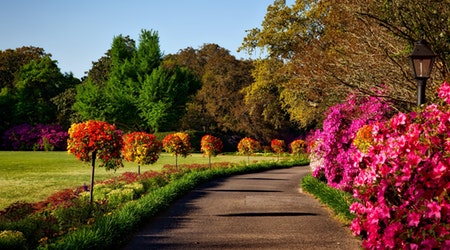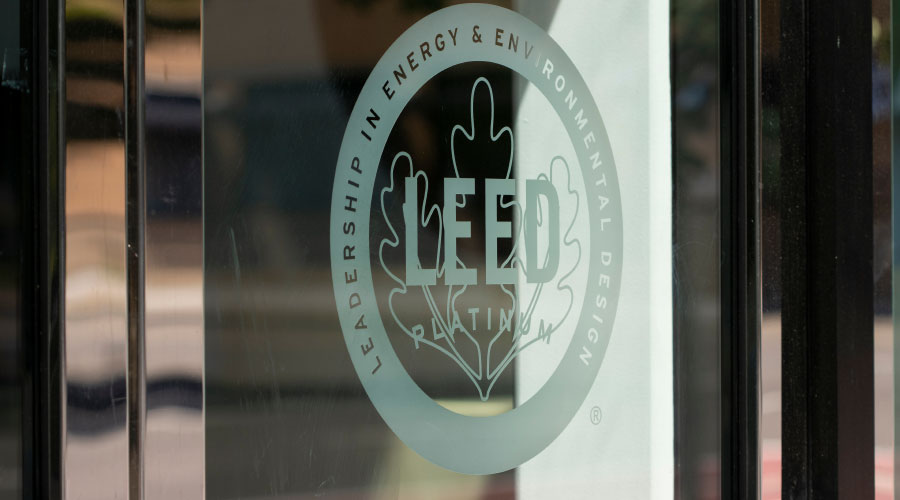Center for Sustainable Landscapes Building First to Achieve WELL Platinum Certification
OTHER PARTS OF THIS ARTICLEPt. 1: This Page
The Center for Sustainable Landscape (CSL) facility at the Phipps Conservatory and Botanical Gardens in Pittsburgh has become the first building to achieve WELL Platinum Pilot Certification — the highest rating awarded by the International WELL Building Institute (IWBI). This facility is also expected to be the first project to meet the Living Building Challenge — for which Net Zero Energy Certification was attained from the International Living Future Institute in May 2014 — in tandem with LEED Platinum and Four-Stars Sustainable Sites Initiative (SITES) certification for landscapes, both of which were earned in 2013.
The WELL Building Standard is the world’s first building standard to focus on enhancing health and well-being through the built environment. Created through seven years of collaboration with leading physicians, scientists, and industry professionals, it is a performance-based certification system that marries best practices in design and construction with evidence-based medical and scientific research.
The CSL earned the distinction based on seven performance categories — air, water, light, nourishment, fitness, comfort, and mind— and achieved a Platinum Pilot level rating, becoming the first project to meet IWBI’s highest standard.
“The CSL was created to demonstrate important connections between human and ecological health, and to highlight the ways in which the built environment intersects with nature,” says Phipps Executive Director Richard V. Piacentini. “We are honored to be among the first institutions to achieve the Well Building Standard, leading by example as we promote design and operation methods that improve quality of life.”
Project features that helped Phipps achieve its WELL Platinum Pilot rating for the CSL include:
— Air Quality Standards: Indoor air quality testing was conducted, confirming that the building is providing occupants with high quality air. The design met stringent thresholds for low levels of volatile substances, particulate matter and inorganic gases.
— Water Quality Standards: IWBI verified that the project is delivering healthy and safe drinking water. Source water was tested for harmful impurities and contaminants and to ensure compliance with the Environmental Protection Agency’s Drinking Water Standards.
— Humidity Control: Relative humidity levels are being monitored and devices are in place to maintain healthy humidity levels, which facilitates increased occupant comfort and higher indoor air quality, as well as prevents harmful biological growth.
— Sun and Glare Control: Internal and external solar shading has been installed to reduce heat penetration by sunlight and to control visual acuity, protecting occupants from uncomfortable thermal
fluctuations and glare.
— Activity Based Lighting: To reduce eyestrain, lighting has been designed to reach balanced and proper illumination levels while task lights have been implemented to allow adequate levels of light.
— Wellness Literacy: To encourage the behaviors necessary for a healthy lifestyle, occupants have access to the latest health and wellness literature, as well as comprehensive guides that describe the various wellness features throughout the building.
— Healthy Ingredients: Drinks and foods distributed do not contain trans fats or high levels of refined ingredients as increased access to healthy foods encourages occupants to develop wholesome eating habits and maintain a healthy weight.
— Ergonomics: Comprehensive ergonomic solutions, such as sit/stand desks and ergonomically designed workstation chairs, have been introduced to help prevent stress and bodily injury.
— Circadian Lighting: Occupants have exposure to daylight in their workspaces, as well as access to indoor and outdoor gardens that provide natural light throughout the year. These spaces supply light intensity to reinforce the natural patterns of the human circadian rhythm — the biological system that controls sleep and wake cycles — that enhances occupant productivity and energy.
— Non-Toxic Materials: In accordance with WELL and the Living Building Challenge, Phipps banned the use of more than a dozen chemicals and materials in furniture and finishes that have been proven to be harmful to human health.
— Cleaning Protocol: A specialized, chemical-free cleaning plan has been put into effect to reduce bioloads, pests, allergens and odors that affect both indoor air quality and occupant comfort.
A home-base for environmental education and research, as well as a space for visitors to explore, the CSL also incorporates many features of biophilia that improve occupant mood through patterns of nature. This is achieved through visual and auditory biophilic art and a restorative landscape with native plants. In addition, the CSL achieves enhanced ventilation for occupant comfort while aiming to achieve net-zero energy with geothermal wells, a vertical axis wind turbine and solar photovoltaics. Operable high performance low-e windows provide fresh air, natural light and views of nature, and Phipps offers employees free nutrition workshops and counseling, yoga classes, and other fitness incentives, daily access to organic fruit and more.
“The CSL’s WELL Platinum Pilot Certification demonstrates outstanding healthy building leadership,” says IWBI Founder Paul Scialla. “IWBI’s mission is to bring human health to the forefront of building practices globally, and it is leaders in the building industry like Phipps that are helping to advance this movement and show the world how we can push building projects to new heights of sustainability.”
Administered by IWBI, the WELL Building Standard is third-party certified through IWBI’s collaboration with the Green Building Certification Institute (GBCI). Following a two-year pilot program and a formal peer review process, Version 1.0 of the WELL Building Standard was publicly released on October 20, 2014 at the inaugural WELL Building Symposium in New Orleans.
Related Topics:












